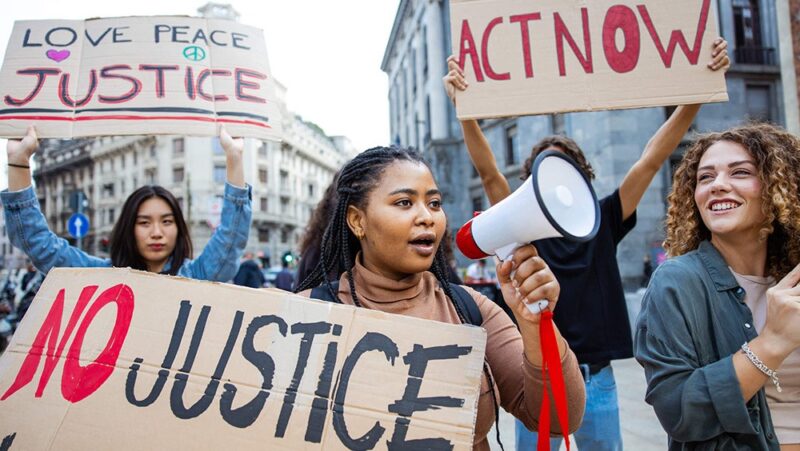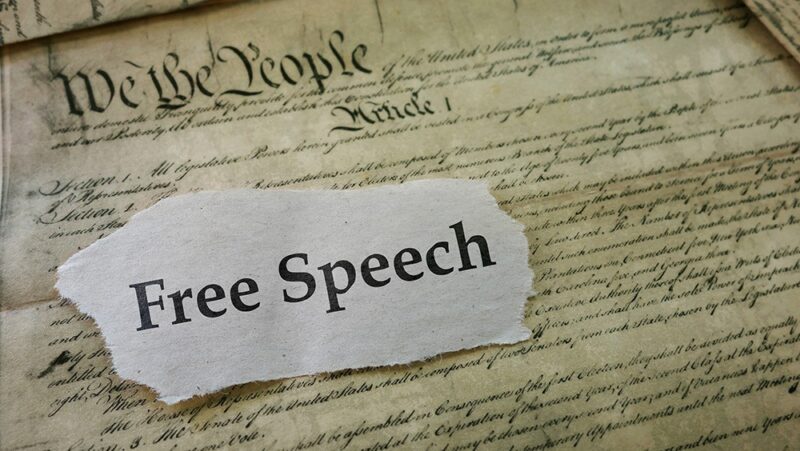Free Speech on College Campuses: The Ultimate Guide
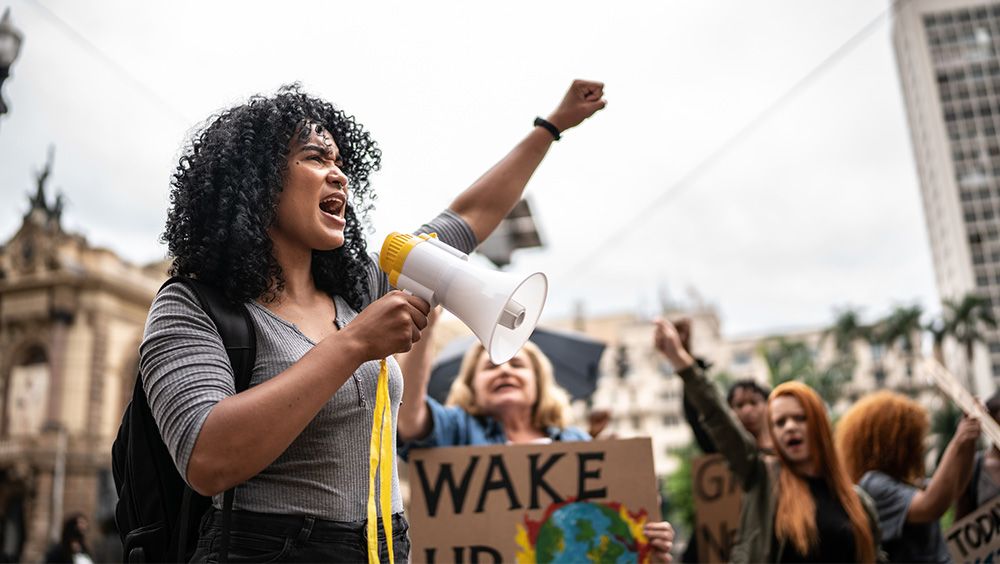
How free is speech today on public university and college campuses – and how free should it be?
Surveys report that with social media’s megaphone and with students often focused on what should not be said in the name of fairness, diversity and inclusion, the landscape for free speech on college campuses has changed.
First Amendment campus conflicts once centered on administrators limiting campus speech or the content of student publications with speech codes and “free speech zones.”
Now, new and urgent issues include calls for “safe spaces” and “trigger warnings,” advance alerts or exclusion of material or topics seen as offensive, disturbing or insulting to some.
Each semester also brings a flurry of protests over guest speakers invited to campus, ranging from vocal protests to attempts to prevent the speaker from delivering remarks or participating in a program, as well as protests over other issues important to students, such as the Israel-Hamas war.
RELATED: Protesting on college campuses: FAQs answered
FAQ: Which colleges and universities are bound by the First Amendment?
Answer: The First Amendment applies only to government entities, which includes public college and universities. The rules around free speech on private universities’ campuses are a little more complicated. If a private institution voluntarily declares free speech protection, it is bound by that promise. And some state laws provide protection for student speech, and at times for student press freedom, even at private colleges.
To what extent does the First Amendment protect free speech on college campuses? Let’s look at several common issues around free speech on campus.
Regulating free speech on college campuses
Can speech on college campuses be regulated by speech codes?
Speech codes are rules or policies that try to regulate free speech or free expression. They may often be found in student handbooks, university regulations or even state laws and have gained ground in recent years, from banning obscene speech and threats to also address gender-based harassment and hateful speech directed at racial minorities and LGBTQ+ communities. In addition to punishing certain speech, they may require "trigger warnings" when sensitive or controversial topics are introduced into the classroom or other campus conversations.
Legal backing for such codes often cites court decisions including U.S. Supreme Court rulings (Chaplinsky v. New Hampshire, 1942; Watts v. United States, 1969) that established exceptions to free speech for things like obscenity, defamation, fighting words and true threats, which neither contribute to the expression of ideas nor have any value for society.
But speech code opponents have had success in asking courts to strike down such campus rules as vague or as applied too widely and thus chilling free speech more than protecting a vulnerable group.
Even opponents of such codes concede the regulations often are adopted in pursuit of admirable goals: countering racism and discrimination and combatting sexual harassment. But critics say far too often such codes run afoul of First Amendment protections by attempting to regulate viewpoints or punish expression that – while offensive to some – represents disparate viewpoints.
Courts continue to consider questions of free speech on campus potentially in conflict with new university speech policies. For example, “bias teams” investigate potentially biased speech on campuses. Such teams, usually administrators but sometimes including campus police, track and investigate reports of bias, according to each university’s definition of the term – and many teams have the authority to recommend discipline. Among federal circuit courts, three have ruled that the teams operate within university authority while two circuits say they chill student speech.
Can colleges regulate speech on social media?
“Most college students today have grown up surrounded by social media. An enormous amount of their ‘speech’ takes place on digital platforms,” Freedom Forum Fellow Lata Nott noted in a 2017 report.
Nott found that courts across the nation have sometimes taken contradictory positions on the reach and authority of college administrators to discipline, punish or expel students based on the content of their social media posts.
Lacking a U.S. Supreme Court decision directly discussing the regulation of college campus speech, scholars raise concerns that lower courts considering campus speech may look to cases involving public high schools.
One such standard might come from the 2021 case of a high school cheerleader’s vulgar social media post. The U.S. Supreme Court held that school officials could not punish speech on social media that originated off-campus, outside school hours and – while discussed at school – did not disrupt classes. The court did leave the door open to extend the reach of school officials into social media, noting technology in the area is changing rapidly.
But applying such decisions to college-level speech faces challenges, not the least of which is that most college students are over 18 and no longer minors.
RELATED: Free speech in schools: What can students say?
Are controversial speakers protected as free speech on campus?
Public colleges and universities are not required to invite speakers of any kind to their campuses. But the First Amendment prevents administrators from banning speakers because of their views or what they will say. Schools cannot withhold campus facilities or support for speakers invited by students or student groups that the schools would usually offer. And if a university allows outside organizations to use its facilities for events, it also cannot discriminate on the basis of content. Shouting down or otherwise preventing someone from speaking is problematic from a free speech perspective. While students and faculty have free-speech rights to voice opposition to or criticize a speaker, an invited speaker – even if controversial or offensive to many – also has a free-speech right to be heard.
Today, objections to campus speakers often focus on claims of societal harm or personal injury if certain ideas are expressed. Justifications are that exposure to such views has adverse effects on the mental or physical health of students and that a university should not be supporting – even by simply providing a platform to be heard – certain ideas or concepts.
Surveys by the Knight Foundation and Freedom Forum have consistently found that most students say colleges should allow students to be exposed to all types of speech, including political speech that is offensive or biased, rather than prohibiting speech they may find offensive.
Can free speech on college campuses be subject to free speech zones?
Free speech zones on college campuses are designated places for speakers and protesters, sometimes requiring advance registration or permission to use.
While more than two-thirds of public colleges and universities surveyed still maintain speech codes, so-called “free speech zones” on campuses have faced increasing and successful challenges in recent years, according to the Foundation for Individual Rights and Expression.
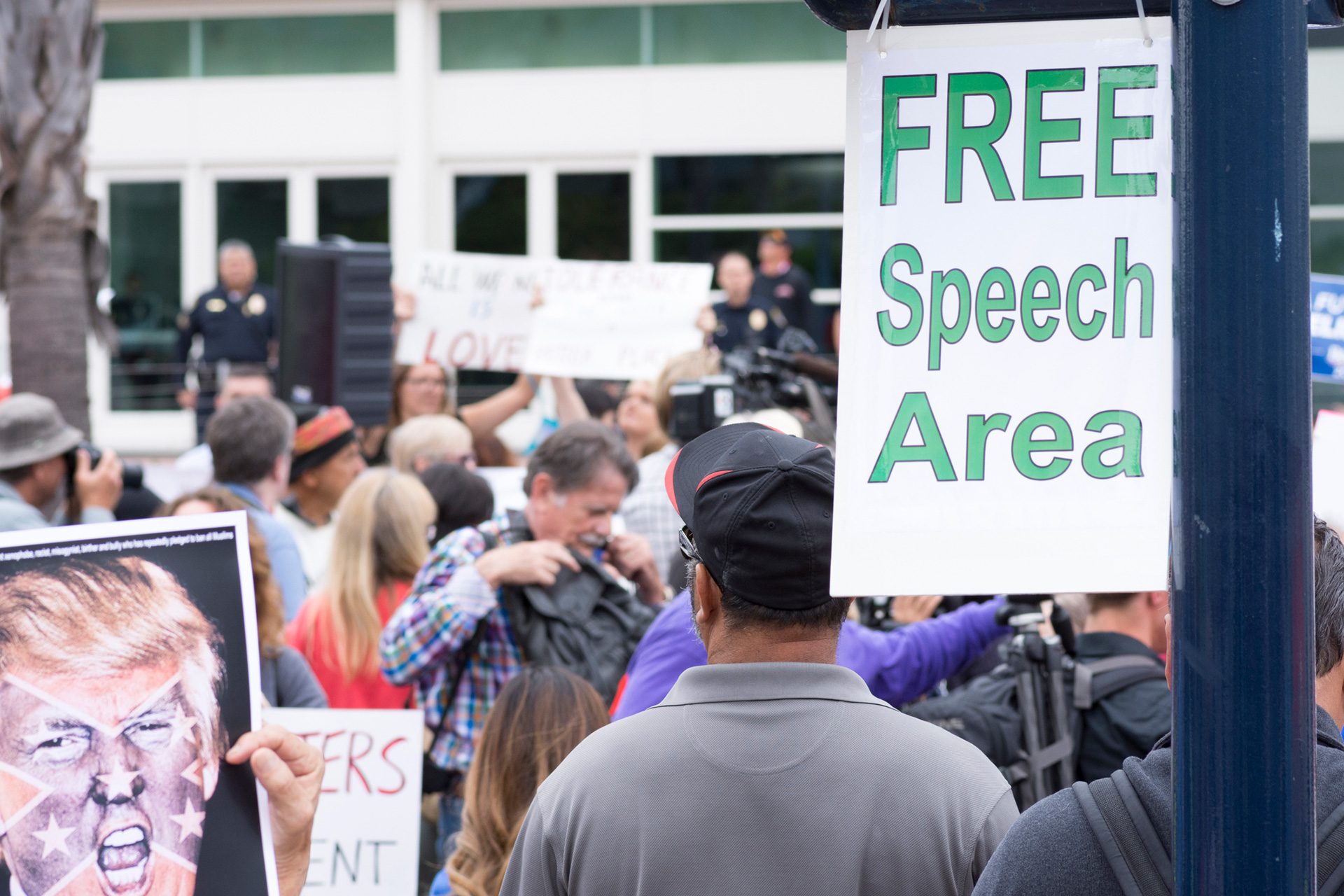
Sign marking designated free speech area at a protest outside a Trump rally held at San Diego Convention Center
Over the years, courts have held that such zones cannot be placed in far-off locations with the intention of hiding the speakers from most students. Some administrators argue that noise or congestion in central areas interferes with the educational mission or with student movement.
Courts have to determine if those reasons are legitimate or simply backdoor methods of preventing speech. Another legal challenge to free speech zones: If administrators do not treat all speakers equally in the rules for and use of the zones, they may violate free speech rights on campus.
Are student publications protected as free speech on college campuses?
There are no U.S. Supreme Court cases that directly involve how and when school administrators may control, direct or censor student-run publications at public colleges.
A 1969 decision (Tinker v. Des Moines Independent Community School District) established a general principle that student journalists – and other schoolhouse speakers, including faculty – have full First Amendment protection, except when their actions substantially disrupt the educational process or intrude on the rights of others. The Supreme Court has also said (Hazelwood School District v. Kuhlmeier) that school-sponsored publications are subject to greater control whenever educators identify a legitimate educational reason for doing so.
Both these cases referred to high school publications. Courts are split on their application to college publications. In 2001, an appeals court ruled that a university yearbook could not be censored, saying college publications should not automatically be considered in the same way as those in high schools.
On the other hand, according to Freedom Forum scholar David L. Hudson, in 2005, an appeals court relied on the Hazelwood standard to rule that a university wasn’t violating First Amendment rights when it censored a university-funded publication. Courts have also ruled similarly “in cases involving curricular disputes, professionalism concerns and even the online speech of college and university students.”
And several courts have ruled that although a public college may require pre-publication submission to an adviser for comments on form and style, what goes into the paper is up to student editors.
Universities are not required to support or fund student papers, literary magazines or yearbooks, but they cannot discontinue funding or support simply because they disagree with the messages of those publications.
When does sexual harassment lose free speech protections on campus?
Universities receiving federal funds must investigate speech involving possible sexual harassment.
As Hudson has written, “The courts have struggled to come up with a consistent way to balance a university’s duty to prevent sexual harassment with its duty to protect freedom of speech and academic freedom.”
The U.S. Department of Justice at one time defined speech that did not have First Amendment protection as involving any reference of a sexual nature that was offensive to the person hearing it. However, since 2017, the U.S. Department of Education has proposed schools use a definition of sexual harassment consistent with a 1999 Supreme Court ruling (Davis v. Monroe County Board of Education), which said harassment must be severe and pervasive such that the affected student is effectively denied access to education. Courts are split in how they have applied this standard in practice.
Is sports fan speech at public colleges protected?
The issue of regulating profane and vulgar speech of sports fans is much easier to settle for private colleges than state-supported institutions. First Amendment protections apply to government, so private schools can set arena or stadium speech policies as they wish.
At state school sports events, on one hand, students and others on campus do not cede their right to free expression at the event doorway. But state schools do have a responsibility for safety, and some scholars argue that sports events are included under a university’s educational role to model and teach civility and respect for others.
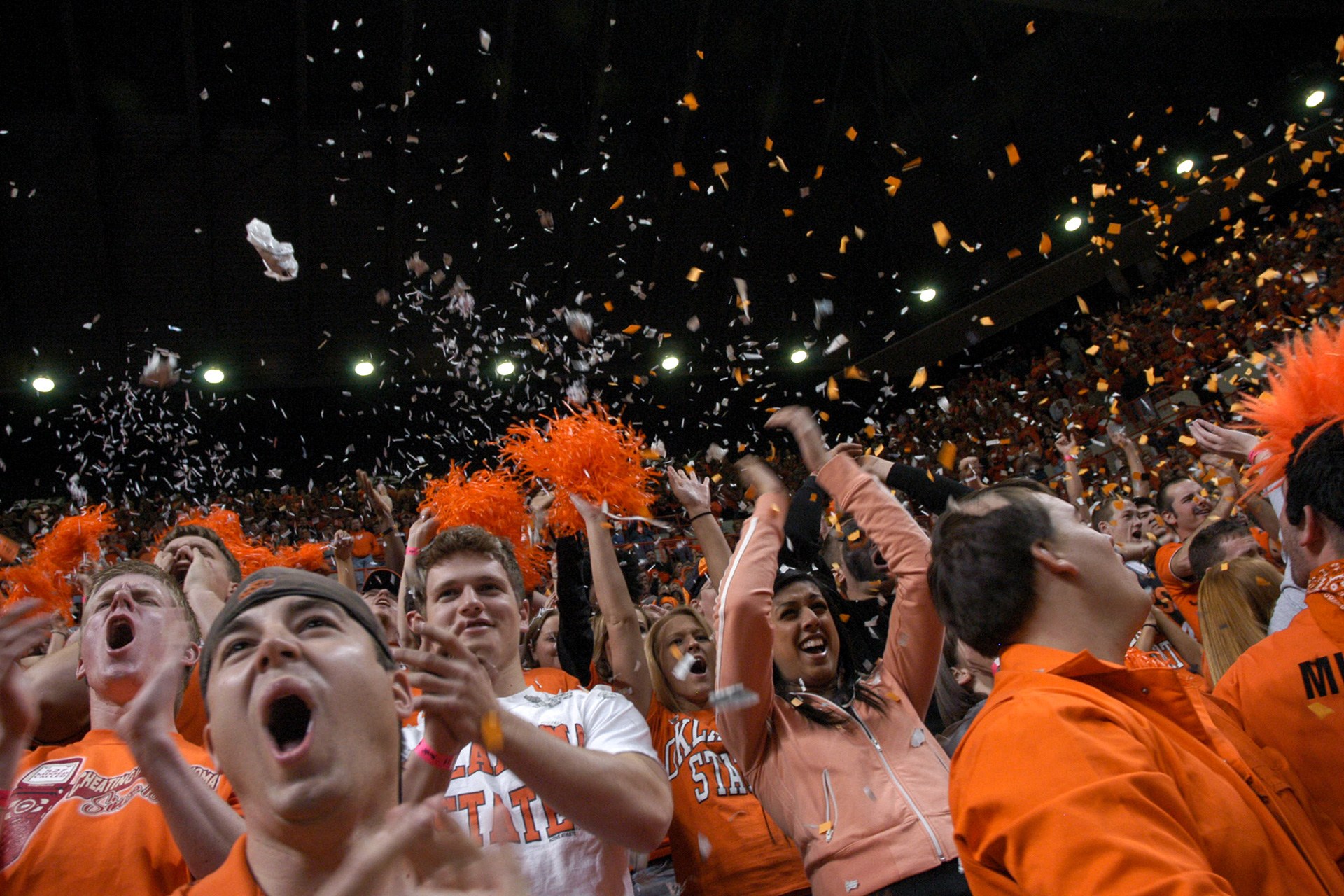
Basketball fans cheer for their team at Oklahoma State University
For many scholars, the analysis of regulating fan speech at public institutions starts with two non-sports U.S. Supreme Court decisions:
- In 1969, the court said in a case involving student arm bands protesting the Vietnam War (Tinker v. Des Moines Independent Community School District) that, “Students don’t shed their constitutional rights at the schoolhouse gate,” setting a standard that student speech is protected unless it substantially disrupts or interferes with school operations.
- In 1971, the court said (Cohen v. California) that the government generally cannot criminalize the display of profane words in public places.
The issue has ramped up in significance in the past decade or so, as games see fans directing frequent profanity, personal insults or even threats at opposing teams or referees.
One area of fan expression not in dispute is conduct deemed hazardous or threatening, such as tossing coins onto a basketball court or hurling ice or snowballs onto a football field. The First Amendment protects expressive conduct, but a court likely would find those dangerous acts are outside such protection.
Do student fees and clubs get free speech protections on campus?
Public colleges and universities often require students to pay activity fees to help support some sports programs, clubs and student government, and subsidize student publications.
Several Supreme Court decisions and college practices have set out a general framework for disbursing such fees and for recognizing some students may say funding specific operations goes against their personal or religious beliefs.
- Once universities establish such a fee and use, the school may not refuse recognition or funding of student groups or activities because it dislikes the group’s viewpoint or activity.
- Schools may offer students an “opt-out” option on that portion of the fee that would go to the activity to which the student objects.
A more controversial option is for schools to require any such fee-funded activity be open to all students.
Does the “Chicago Statement” protect or harm free speech on college campuses?
A touchstone for many college administrators in considering free speech on campus is the “Chicago Statement” adopted in 2014 by the University of Chicago and by some 100 institutions since.
Among its broad declarations, according to a summary prepared by FIRE:
- Emphatically guarantees “all members of the university community the broadest possible latitude to speak, write, listen, challenge, and learn,” with exceptions only “for narrowly defined categories of unlawful expression such as defamation and harassment.”
- Civility concerns cannot silence important conversations “however offensive or disagreeable those ideas may be to some members of our community.”
- University communities can respond to controversial speech “not by seeking to suppress. . . but by openly and vigorously contesting the ideas that they oppose.”
- Universities are responsible for protecting and promoting open conversation, and “They may not obstruct or otherwise interfere with the freedom of others to express views they reject or even loathe.”
Critics of the statement say it fails a primary mission of a university to seek truth, not merely serve as a platform for ideas that may include bias, misinformation and disinformation, and it perpetuates an unequal social, economic, or psychological burden on non-majority students.
Where do students stand regarding free speech on college campuses?
Freedom Forum surveys have found that it is increasingly important to Americans that college campuses foster the free exchange of ideas, even if those ideas are offensive to some. However, younger respondents are the least likely to agree, and members of Generation Z are least likely to say the First Amendment is extremely vital overall compared to older generations.
Similarly, Knight Foundation student surveys have found:
- Students continue to believe First Amendment rights and concepts of free speech are important to democracy. However, the percentage of students saying speech rights are secure has fallen year by year.
- Students of color believe their speech is less protected. While a majority of college students express confidence that the First Amendment protects “people like them,” Black students in particular feel much less protected.
- Students say the campus climate stifles free expression, yet speech on campus is making nearly 1 in 5 feel unsafe. Growing numbers of students say the climate at school prevents some people from saying things others might find offensive, and fewer feel comfortable disagreeing in class. Yet slightly more also report feeling unsafe because of comments made on campus. This is particularly true for female students and students of color.
Knight also found that while most students favor policies that restrict racial slurs on campus, just 1 in 4 students favor schools disinviting controversial speakers. The number of students who support safe spaces or speech codes has also fallen.
What’s the bottom line regarding free speech on college campuses?
“The essentiality of freedom in the community of American universities is almost self-evident,” then-Chief Justice Earl Warren wrote in a landmark 1957 U.S. Supreme Court decision (Sweezy v. New Hampshire). “Scholarship cannot flourish in an atmosphere of suspicion and distrust. Teachers and students must always remain free to inquire, to study and to evaluate, to gain new maturity and understanding, otherwise our civilization will stagnate and die.”
Still, the court has left open a legal door for public universities to ban or punish intimidation and actions that disrupt the process of education. Where exactly that line is drawn is a matter of continual testing and refining.
Gene Policinski, a senior fellow for the First Amendment at the Freedom Forum, compiled this report with First Amendment Specialist Kevin Goldberg based on scholarship by Freedom Forum fellows and experts.
15 Freedom of Assembly Examples You Should Know
18 Freedom of Speech Quotes You Should Know
Related Content
2025 Al Neuharth Free Spirit and Journalism Conference
All-Expenses-Paid Trip To Washington, D.C.
June 22-27, 2025
Skill-Building
Network Growing
Head Start On Your Future
